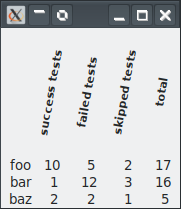Inheriting Widget Classes
Introduction
There are situations in your projects that a widget gets dressed up the same way all the time and do not use the defaults of a widget. For instance, you might want several labels to change a font and make it bold. So you repeat the steps all the time you create a label. For example the below label has a smaller font and printed bold. Also rotated for 90 degrees (useful in a grid to keep columns small, e.g. for showing checkboxes or small numbers);
$text = "<b><small>$text</small></b>";
my Gnome::Gtk3::Label $label .= new(:$text);
$label.set-use-markup;
$label.set-angle(90);
Of course, we can make a method to do all that and that is easy enough. In some cases it might be the best thing you can do. However, the code can be more readable when such items are put away in some class and a proper name can then describe the result better. Beside that, it can be shared with other projects.
Inheriting
Putting things in a class is the subject then. How on earth can we have the behavior of the label without coding it all again? Well, inheriting the label class is the key to the solution! So, how do we make a class like that? In Raku, we use the is trait in the class declaration to get the behavior of a parent class.
But we must do a bit more to let the parent class process the arguments and generate a native object but not the parent of the parent. In case of a Gnome::Gtk3::AboutDialog class we want AboutDialog to process the arguments but not Gnome::Gtk3::Dialog, Gnome::Gtk3::Container or Gnome::Gtk3::Widget which are parent classes to AboutDialog.
To cope with that problem, we must define a new() method for it to bless() the class to a living object. This method creates the Raku object while providing the necessary options for the parent class, if there are any but most importantly, it must provide a special option :GtkLabel, in our example, to let the label build routine know that it must process the options to create a native label object. Of course, other widget types need other named arguments like GtkAboutDialog for the inheritance of an AboutDialog. The reference documentation of a widget makes it clear if it can be inherited and which argument must be given.
Then the BUILD() must do the additional steps to let the new label type be what it should be. This time rotating a smaller angle.
The code for it could look like the example below;
use Gnome::Gtk3::Label;
unit class VerticalHeaderLabel is Gnome::Gtk3::Label;
submethod new ( |c ) { # ①
self.bless( :GtkLabel, |c); # ②
}
submethod BUILD ( ) { # ③
my Str $text = '<b><small>' ~ self.get-text ~ '</small></b>';
self.set-text($text);
self.set-use-markup(True);
self.set-line-wrap(False);
self.set-width-chars(16);
self.set-angle(80);
}
Example use;
my Gnome::Gtk3::Grid $grid .= new;
my Int $col = 1;
# Here it show the use of the created class
for ('success tests', 'failed tests', 'skipped tests', 'total') -> $hdr {
my VerticalHeaderLabel $v .= new(:text($hdr)); # ④
$grid.attach( $v, $col++, 0, 1, 1);
}
# The rest is just filling up the table
my $data = [
( 'foo', 10, 5, 2, 17),
( 'bar', 1, 12, 3, 16),
( 'baz', 2, 2, 1, 5),
];
my Int $row = 1;
for @$data -> @d {
my Int $col = 0;
for @d -> $col-data {
my Str $text = $col-data ~~ Str
?? $col-data.fmt('%5s') !! $col-data.fmt('%3d');
$grid.attach(
Gnome::Gtk3::Label.new(:$text), $col++, $row, 1, 1
);
}
$row++;
}
A bit of explanation is in order…
① |c is used here to get the lot of arguments in a Capture.
② Then, c is flattened in the call to bless. Note the :GtkLabel is used here to give Gnome::Gtk3::Label a signal to process the named arguments like :text. It is also possible to provide named arguments there to symplify the users call to initialize.
③ The BUILD routine in this example gets the label text to add some markup. Also it needs to turn on markup processing. The angle is now set to 80 degrees so that it is not completely vertical. Note that BUILD will get the same arguments as new and more, depending if any are added in new.
④ In the second part of the example, you see the usage of the class brought back to a single line where there is no fuzz about bolding and what not.
And naturally you want to see the result!

You need however a window around it and start the main loop, but that, you already knew 😄
Inheriting another level
It is possible to inherit the VerticalHeaderLabel too to make further adjustments. The new method however, must be repeated in the newer class. This is because Raku only runs the new() method of the class mentioned in the declaration.
A caveat
A problem was noted by Grenzionky in issue #23. He had created a new class inheriting from a Label class. This new class, called ExtendedLabel, also had some attributes added. The object created with this class and the attributes set to their values, was added to a Gnome::Gtk3::Notebook and later retrieved by calling .get-n-pages().
The problem now is that the object given to Notebook and then later returned, is a native object. When imported into the ExtendedLabel class using :native-object, it did not get the proper values for its attributes set before.
This behavior can be explained as the native routines only know about the native object which is the C representation of the widget. The Raku classes only function as a wrapper around such an object and make the native routines available as methods. The methods get the native object from the used classes and provide or retrieve them to or from the native subroutines.
However, do not despair! There are ways to add data to the native object which is explained in Object.